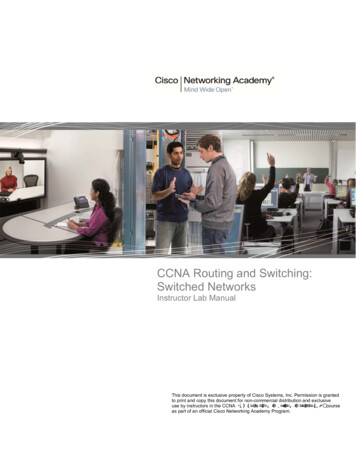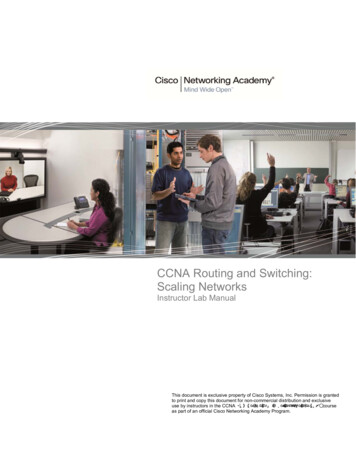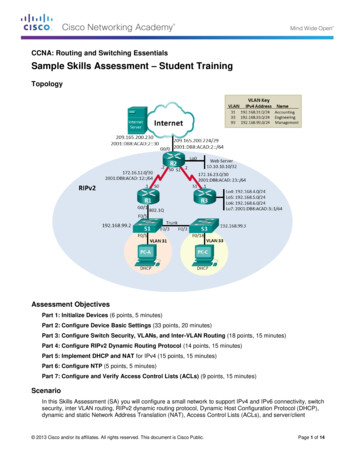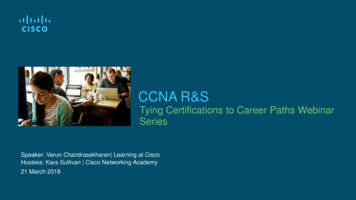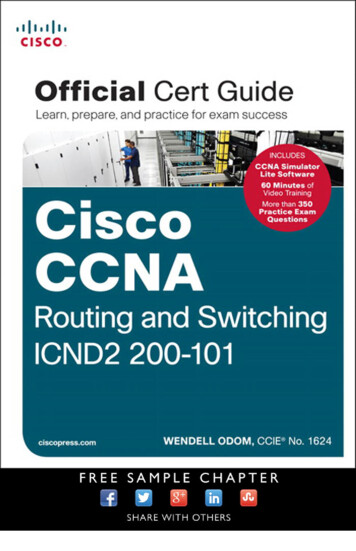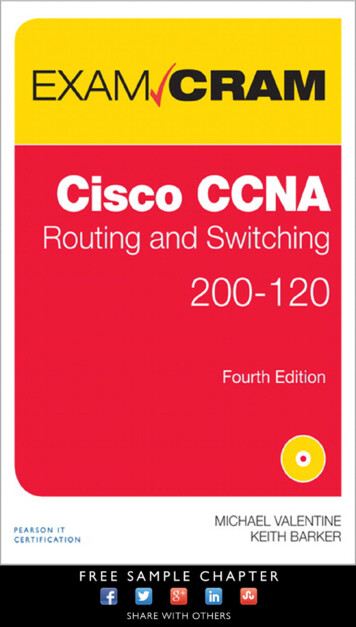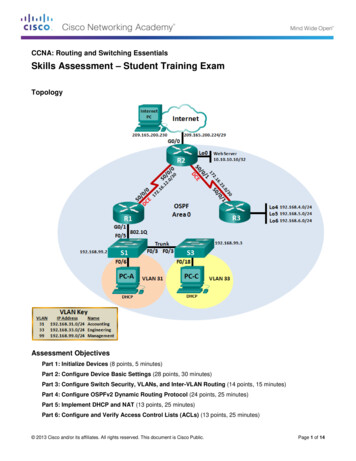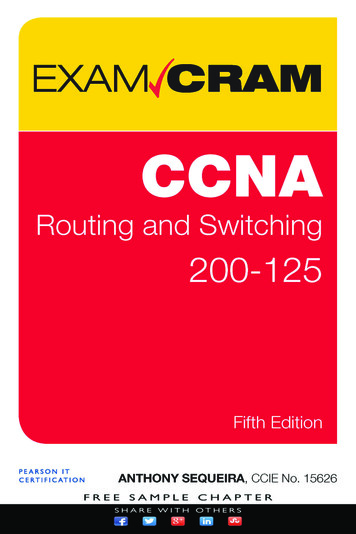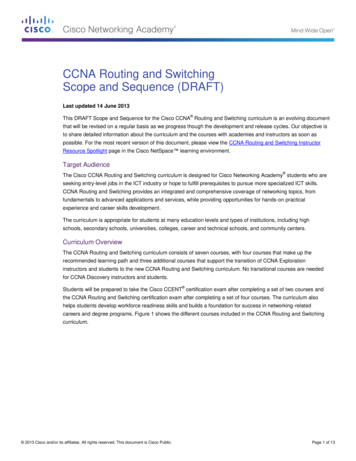
Transcription
CCNA Routing and SwitchingScope and Sequence (DRAFT)Last updated 14 June 2013 This DRAFT Scope and Sequence for the Cisco CCNA Routing and Switching curriculum is an evolving documentthat will be revised on a regular basis as we progress though the development and release cycles. Our objective isto share detailed information about the curriculum and the courses with academies and instructors as soon aspossible. For the most recent version of this document, please view the CCNA Routing and Switching InstructorResource Spotlight page in the Cisco NetSpace learning environment.Target Audience The Cisco CCNA Routing and Switching curriculum is designed for Cisco Networking Academy students who areseeking entry-level jobs in the ICT industry or hope to fulfill prerequisites to pursue more specialized ICT skills.CCNA Routing and Switching provides an integrated and comprehensive coverage of networking topics, fromfundamentals to advanced applications and services, while providing opportunities for hands-on practicalexperience and career skills development.The curriculum is appropriate for students at many education levels and types of institutions, including highschools, secondary schools, universities, colleges, career and technical schools, and community centers.Curriculum OverviewThe CCNA Routing and Switching curriculum consists of seven courses, with four courses that make up therecommended learning path and three additional courses that support the transition of CCNA Explorationinstructors and students to the new CCNA Routing and Switching curriculum. No transitional courses are neededfor CCNA Discovery instructors and students. Students will be prepared to take the Cisco CCENT certification exam after completing a set of two courses andthe CCNA Routing and Switching certification exam after completing a set of four courses. The curriculum alsohelps students develop workforce readiness skills and builds a foundation for success in networking-relatedcareers and degree programs. Figure 1 shows the different courses included in the CCNA Routing and Switchingcurriculum. 2013 Cisco and/or its affiliates. All rights reserved. This document is Cisco Public.Page 1 of 13
Figure 1.CCNA Routing and Switching CoursesIn each course, Networking Academy students will learn technology concepts with the support of interactivemedia and apply and practice this knowledge through a series of hands-on and simulated activities that reinforcetheir learning.CCNA Routing and Switching teaches comprehensive networking concepts and skills, from network applications tothe protocols and services provided to those applications by the lower layers of the network. Students will progressfrom basic networking to more complex enterprise and theoretical networking models later in the curriculum.CCNA Routing and Switching includes the following features: Students learn the basics of routing, switching, and advanced technologies to prepare for the Cisco CCENTand CCNA certification exams, networking related degree programs, and entry-level networking careers. The language used to describe networking concepts is designed to be easily understood by learners at alllevels and embedded interactive activities help reinforce comprehension. Courses emphasize critical thinking, problem solving, collaboration, and the practical application of skills. Multimedia learning tools, including videos, games, and quizzes, address a variety of learning styles andhelp stimulate learning and promote increased knowledge retention. Hands-on labs and Cisco Packet Tracer simulation-based learning activities help students develop criticalthinking and complex problem solving skills. Embedded assessments provide immediate feedback to support the evaluation of knowledge and acquiredskills.Course Structure and SequencesMarket research and global employers have consistently indicated that the skills gap for general networking skills isshrinking, while the skills gap for essential networking technologies such as security, voice and wireless, and foremerging technologies such as data center, cloud, and video, is growing. As a global leader in technology andnetworking, Cisco developed the new CCENT and CCNA Routing and Switching certifications and curriculum toremain aligned with the rapidly changing global job market and trends. 2013 Cisco and/or its affiliates. All rights reserved. This document is Cisco Public.Page 2 of 13
As a result of the changes to the certification exams, students can choose to pursue Cisco advanced technologycertifications after achieving the prerequisite CCENT certification. The recommended CCNA Routing and Switchingcourse flow supports student flexibility by helping students prepare for the CCENT certification exam after the firsttwo courses, and helps them prepare for the CCNA exam after completing all four courses.Figure 2 shows the four courses that make up the recommended CCNA Routing and Switching course sequence,Introduction to Networks, Routing and Switching Essentials, Scaling Networks, and Connecting Networks.Networking Academy strongly encourages all academies to teach this recommended course sequence, sincethese courses may significantly enhance employment opportunities by enabling students to acquire skills they canimmediately use in their jobs, and may accelerate their ability to pursue advanced technology certifications.Figure 2.Recommended CCNA Routing and Switching Course FlowThe three additional courses shown in Figure 3 are designed to support the transition of CCNA Explorationinstructors and students to the new CCNA Routing and Switching curriculum.Figure 3.Additional CCNA Routing and Switching Courses to Support TransitionThe three courses supporting transition, Network Basics, Routing Protocols, and Switched Networks, will beoffered with the following conditions: The courses are being developed and released to support institutions that are not able to transitionimmediately to the recommended four courses. The courses will be retired one year after all of the new courses are released. Target retirement date for thethree additional courses is December 2014. The courses will be offered in English only and will not be translated. The fourth course in this sequence is the same Connecting Networks course used in the recommended flowshown in Figure 2. 2013 Cisco and/or its affiliates. All rights reserved. This document is Cisco Public.Page 3 of 13
Lab Equipment RequirementsDetailed equipment information, including descriptions and part numbers, is available in the CCNA Equipment List,which is located on the Cisco NetSpace Equipment Information site. Please refer to that document for the latestinformation, which includes specifications for the following minimum equipment required: 3 CISCO1941/K9 Integrated Services Routers Generation 2 (ISR-G2) 3 HWIC-2T Serial WAN Interface Cards 3 WS-C2960-24TT-L Cisco Catalyst switches 2 Linksys EA Series routers (2700, 3500, 4500) or equivalent Assorted Ethernet and Serial cables and hubsRecommended Courses OutlinesTable 1.ChapterIntroduction to Networks and Routing and Switching Essentials Course OutlinesIntroduction to NetworksRouting and Switching Essentials1Exploring the NetworkIntroduction to Switched Networks2Configuring a Network Operating SystemBasic Switching Configuration3Network Protocols and CommunicationsVLANs4Network AccessRouting Concepts5EthernetInter-VLAN Routing6Network LayerStatic Routing7Transport LayerRouting Dynamically8IP AddressingSingle-Area OSPF9Subnetting IP NetworksAccess Control Lists10Application LayerDHCP11It’s a NetworkNetwork Address Translation for IPv4Introduction to NetworksThis course introduces the architecture, structure, functions, components, and models of the Internet and othercomputer networks. The principles and structure of IP addressing and the fundamentals of Ethernet concepts,media, and operations are introduced to provide a foundation for the curriculum. By the end of the course, studentswill be able to build simple LANs, perform basic configurations for routers and switches, and implement IPaddressing schemes.Students who complete Introduction to Networks will be able to perform the following functions: Understand and describe the devices and services used to support communications in data networks andthe Internet Understand and describe the role of protocol layers in data networks Understand and describe the importance of addressing and naming schemes at various layers of datanetworks in IPv4 and IPv6 environments Design, calculate, and apply subnet masks and addresses to fulfill given requirements in IPv4 and IPv6networks Explain fundamental Ethernet concepts such as media, services, and operations 2013 Cisco and/or its affiliates. All rights reserved. This document is Cisco Public.Page 4 of 13
Build a simple Ethernet network using routers and switches Use Cisco command-line interface (CLI) commands to perform basic router and switch configurations Utilize common network utilities to verify small network operations and analyze data trafficRouting and Switching EssentialsThis course describes the architecture, components, and operations of routers and switches in a small network.Students learn how to configure a router and a switch for basic functionality. By the end of this course, students willbe able to configure and troubleshoot routers and switches and resolve common issues with RIPv1, RIPv2, singlearea and multi-area OSPF, virtual LANs, and inter-VLAN routing in both IPv4 and IPv6 networks.Students who complete the Routing and Switching Essentials course will be able to perform the following functions: Understand and describe basic switching concepts and the operation of Cisco switches Understand and describe enhanced switching technologies such as VLANs, VLAN Trunking Protocol (VTP),Rapid Spanning Tree Protocol (RSTP), Per VLAN Spanning Tree Protocol (PVSTP), and 802.1q Configure and troubleshoot basic operations of a small switched network Understand and describe the purpose, nature, and operations of a router, routing tables, and the routelookup process Configure and verify static routing and default routing Understand and describe how VLANs create logically separate networks and how routing occurs betweenthem Understand and describe dynamic routing protocols, distance vector routing protocols, and link-state routingprotocols Configure and troubleshoot basic operations of routers in a small routed network: Routing Information Protocol (RIPv1 and RIPv2) Open Shortest Path First (OSPF) protocol (single-area OSPF) Configure and troubleshoot VLANs and inter-VLAN routing Understand and describe the purpose and types of access control lists (ACLs) Configure, monitor, and troubleshoot ACLs for IPv4 and IPv6 Understand and describe the operations and benefits of Dynamic Host Configuration Protocol (DHCP) andDomain Name System (DNS) for IPv4 and IPv6 Understand and describe the operations and benefits of Network Address Translation (NAT) Configure and troubleshoot NAT operations 2013 Cisco and/or its affiliates. All rights reserved. This document is Cisco Public.Page 5 of 13
Table 2.ChapterScaling Networks and Connecting Networks Course OutlinesScaling NetworksConnecting Networks1Building a Small to Medium-Sized NetworkConnecting to the WAN2DHCPConfiguring Serial Connections3The Spanning Tree ProtocolBroadband Solutions4Link AggregationSecuring Site-to-Site Connectivity5Troubleshooting Layer 2 IssuesMonitoring the Network6Implementing EIGRPTroubleshooting the Network7Implementing Multi-Area OSPFNetwork Architectures8IOS File ManagementScaling NetworksThis course describes the architecture, components, and operations of routers and switches in a larger and morecomplex network. Students learn how to configure routers and switches for advanced functionality. By the end ofthis course, students will be able to configure and troubleshoot routers and switches and resolve common issueswith OSPF, EIGRP, STP, and VTP in both IPv4 and IPv6 networks. Students will also develop the knowledge andskills needed to implement DHCP and DNS operations in a network.Students who complete the Scaling Networks course will be able to perform the following functions: Configure and troubleshoot DHCP and DNS operations for IPv4 and IPv6 Understand and describe the operations and benefits of the Spanning Tree Protocol (STP) Configure and troubleshoot STP operations Understand and describe the operations and benefits of link aggregation and Cisco VLAN Trunk Protocol(VTP) Configure and troubleshoot VTP, STP, and RSTP Configure and troubleshoot basic operations of routers in a complex routed network for IPv4 and IPv6 Open Shortest Path First (OSPF) protocol (single-area OSPF and multi-area OSPF) Enhanced Interior Gateway Routing Protocol (EIGRP) Configure and troubleshoot advanced operations of routers and implement RIP, OSPF, and EIGRP routingprotocols for IPv4 and IPv6 Manage Cisco IOS Software licensing and configuration filesConnecting NetworksThis course discusses the WAN technologies and network services required by converged applications in acomplex network. The course enables students to understand the selection criteria of network devices and WANtechnologies to meet network requirements. Students learn how to configure and troubleshoot network devices andresolve common issues with data link protocols. Students will also develop the knowledge and skills needed toimplement IPSec and virtual private network (VPN) operations in a complex network.Students who complete the Connecting Networks course will be able to perform the following functions: Understand and describe different WAN technologies and their benefits Understand and describe the operations and benefits of virtual private networks (VPNs) and tunneling Configure and troubleshoot serial connections 2013 Cisco and/or its affiliates. All rights reserved. This document is Cisco Public.Page 6 of 13
Configure and troubleshoot broadband connections Configure and troubleshoot IPSec tunneling operations Monitor and troubleshoot network operations using syslog, SNMP, and NetFlow Design network architectures: Borderless networks Data centers and virtualization Collaboration technology and solutionsAdditional Courses Supporting Transition OutlinesTable 3.CCNA Routing and Switching Additional Courses OutlinesCh Network BasicsRouting ProtocolsSwitched Networks1Exploring the NetworkRouting ConceptsIntroduction to Switched Networks2Configuring a Network OperatingSystemStatic RoutingBasic Switching Concepts andConfiguration3Network Protocols and Communications Routing DynamicallyVLANs4Application LayerEIGRPLAN Redundancy5Transport LayerEIGRP Advanced ConfigurationLink Aggregation6Network LayerSingle-Area OSPFInter-VLAN RoutingIP AddressingAdjust and Troubleshoot Single-AreaOSPFDHCP8Subnetting IP NetworksMulti-Area OSPFWireless LANs9Network AccessAccess Control Lists710 EthernetIOS File Management11 It’s a NetworkNetwork BasicsThis course introduces the architecture, structure, functions, components, and models of the Internet and othercomputer networks. The principles and structure of IP addressing and the fundamentals of Ethernet concepts,media, and operations are introduced to provide a foundation for the curriculum. By the end of this course, studentswill be able to build simple LANs, perform basic configurations for routers and switches, and implement IPaddressing schemes.Students who complete Network Basics will be able to perform the following functions: Understand and describe the devices and services used to support communications in data networks andthe Internet Understand and describe the role of protocol layers in data networks Understand and describe the importance of addressing and naming schemes at various layers of datanetworks in IPv4 and IPv6 environments Design, calculate, and apply subnet masks and addresses to fulfill given requirements in IPv4 and IPv6networks Explain fundamental Ethernet concepts such as media, services, and operations Build a simple Ethernet network using routers and switches 2013 Cisco and/or its affiliates. All rights reserved. This document is Cisco Public.Page 7 of 13
Use Cisco command-line interface (CLI) commands to perform basic router and switch configurations Utilize common network utilities to verify small network operations and analyze data trafficRouting ProtocolsThis course describes the architecture, components, and operations of routers, and explains the principles ofrouting and routing protocols. Students learn how to configure a router for basic and advanced functionality. By theend of this course, students will be able to configure and troubleshoot routers and resolve common issues withRIPv1, RIPv2, EIGRP, and OSPF in both IPv4 and IPv6 networks.Students who complete the Routing Protocols course will be able to perform the following functions: Understand and describe the purpose, nature, and operations of a router, routing tables, and the routelookup process Configure and verify static routing and default routing Understand and describe dynamic routing protocols, distance vector routing protocols, and link-state routingprotocols Configure and troubleshoot basic operations of routers in a complex routed network for IPv4 and IPv6: Routing Information Protocol (RIPv1 and RIPv2) Open Shortest Path First (OSPF) protocol (single-area OSPF and multi-area OSPF) Enhanced Interior Gateway Routing Protocol (EIGRP) Configure and troubleshoot advanced operations of routers and implement RIP, OSPF, and EIGRP routingprotocols for IPv4 and IPv6 Understand and describe the purpose and types of access control lists (ACLs) Configure, monitor, and troubleshoot ACLs for IPv4 and IPv6 Manage Cisco IOS Software licensing and configuration filesSwitched NetworksThis course describes the architecture, components, and operations of a converged switched network. Studentslearn about the hierarchical network design model and how to configure a switch for basic and advancedfunctionality. By the end of this course, students will be able to troubleshoot and resolve common issues withVirtual LANs, VTP, and inter-VLAN routing in a converged network. Students will also develop the knowledge andskills needed to implement a WLAN in a small-to-medium network.Students who complete the Switched Networks course will be able to perform the following functions: Understand and describe basic switching concepts and the operation of Cisco switches Understand and describe enhanced switching technologies such as VLANs, VLAN Trunking Protocol (VTP),Rapid Spanning Tree Protocol (RSTP), Per VLAN Spanning Tree Protocol (PVSTP), and 802.1q Configure and troubleshoot basic operations of a small switched network Understand and describe how VLANs create logically separate networks and how routing occurs betweenthem Configure and troubleshoot VLANs, trunking on Cisco switches, inter-VLAN routing, VTP, and RSTP Understand and describe the operations and benefits of Dynamic Host Configuration Protocol (DHCP) andDomain Name System (DNS) for IPv4 and IPv6 2013 Cisco and/or its affiliates. All rights reserved. This document is Cisco Public.Page 8 of 13
Configure and troubleshoot DHCP and DNS operations for IPv4 and IPv6 Understand and describe the purpose of the components in a small wireless network: Service Set Identification (SSID) Basic Service Set (BSS) Extended Service Set (ESS) Compare and contrast Wi-Fi Protected Access (WPA) security features and the capabilities of open, WiredEquivalent Privacy (WEP), and WPA1/2 networks Configure and troubleshoot basic operations of a small wireless networkRecommended Courses Detailed OutlinesTable 4.Ch.123456Introduction to Networks and Routing and Switching Essentials Detailed Course OutlinesIntroduction to NetworksRouting and Switching EssentialsExploring the NetworkIntroduction to Switched Networks1.1Globally Connected1.1LAN Design1.2LANs, WANs, and the Internet1.2The Switched Environment1.3The Network as a Platform1.4The Changing Network EnvironmentConfiguring a Network Operating SystemBasic Switching Concepts and Configuration2.1IOS Bootcamp2.1Basic Switch Configuration2.2Getting Basic2.2Switch Security: Management and Implementation2.3Addressing SchemesNetwork Protocols and CommunicationsVLANs3.1Rules of Communications3.1VLAN Segmentation3.2Network Protocols and Standards3.2VLAN Implementations3.3Moving Data in the Network3.3VLAN Security and DesignNetwork AccessRouting Concepts4.1Physical Layer Protocols4.1Initial Configuration of a Router4.2Network Media4.2Routing Decisions4.3Data Link Layer Protocols4.3Router Operation4.4Media Access Control4.4VLAN Best PracticesEthernetInter-VLAN Communication5.1Ethernet Protocol5.1Inter-VLAN Routing Configuration5.2Address Resolution Protocol5.2Troubleshoot Inter-VLAN Routing5.3LAN Switches5.3Layer 3 SwitchingNetwork LayerStatic Routing6.1Network Layer Protocols6.1Static Routing Implementation6.2Routing6.2Configure Static and Default Routers6.3Routers6.3Review of CIDR and VLSM6.4Configuring a Cisco Router6.4Configure Summary and Floating Static Routes6.5Troubleshoot Static and Default Route Issues 2013 Cisco and/or its affiliates. All rights reserved. This document is Cisco Public.Page 9 of 13
78910Transport LayerRouting Dynamically7.1Transport Layer Protocols7.1Dynamic Routing Protocols7.2TCP and UPD7.2Distance Vector Routing Protocols7.3RIP and RIPng Routing7.4Link-State Dynamic Routing7.5The Routing TableIP AddressingSingle-Area OSPF8.1IPv4 Network Addresses8.1Characteristics of OSPF8.2IPv6 Network Addresses8.2Configuring Single-Area OSPFv28.3Connectivity Verification8.3Configuring Single-Area OSPFv3Subnetting IP NetworksAccess Control Lists9.1Subnetting an IPv4 Network9.1IP ACL Operation9.2Addressing Schemes9.2Standard IPv4 ACLs9.3Design Considerations for IPv69.3Extended IPv4 ACLs9.4Debug with ACLs9.5Troubleshoot ACLs9.6IPv6 ACLsApplication LayerDHCP10.1 Application Layer Protocols10.1Dynamic Host Configuration Protocol v410.2Dynamic Host Configuration Protocol v610.2Well-Known Application Layer Protocols andServices10.3 The Message Heard Around The World11It’s a NetworkNetwork Address Translation for IPv411.1 Create and Grow11.1NAT Operation11.2 Keeping the Network Safe11.2Configuring NAT11.3 Basic Network Performance11.3Troubleshooting NAT11.4 Managing IOS Configuration Files11.5 Integrated Routing ServicesTable 5.Ch.123Scaling Networks and Connecting Networks Detailed Course OutlinesScaling NetworksConnecting NetworksBuilding a Small to Medium-Sized NetworkConnecting to the WAN1.1Switch Hardware1.1Hierarchical Network Design1.2Router Hardware1.2WAN TechnologiesDHCPConfiguring Serial Connections2.1Implementing DHCP Options2.1Configuring PPP2.2DHCP Operation2.2Configuring Frame Relay2.3Troubleshooting DHCP2.3Troubleshooting WAN ConnectivityThe Spanning Tree ProtocolBroadband Solutions3.1Spanning Tree Operation3.1Compare Broadband Solutions3.2Configuring Spanning Tree3.2Configuring xDSL Connectivity 2013 Cisco and/or its affiliates. All rights reserved. This document is Cisco Public.Page 10 of 13
45678Link AggregationSecuring Site-to-Site Connectivity4.1Link Aggregation Configuration4.1Tunneling4.2Link Aggregation Concepts4.2Configuring IPSec VPN4.3Troubleshooting Link AggregationTroubleshooting Layer 2 IssuesMonitoring the Network5.15.1Syslog Operation5.2SNMP OperationTroubleshooting SwitchingImplementing EIGRPTroubleshooting the Network6.1Characteristics of EIGRP6.1Troubleshooting with a Systematic Approach6.2Configuring EIGRP for IPv46.2Interpreting Network Monitoring Output6.3Operation of EIGRP6.4Configuring EIGRP for IPv66.5Troubleshooting EIGRP ImplementationImplementing Multi-Area OSPFNetwork Architectures7.1Multi-Area OSPFv27.1Borderless Networks7.2Multi-Area OSPF Operation7.2Virtualization7.3Configuring Multi-Area OSPFv37.3Collaboration7.4Troubleshooting Complex OSPF NetworksIOS File Management8.1Managing IOS System Files8.2IOS LicensingAdditional Courses Supporting Transition Detailed OutlinesTable 6.Ch.12Network Basics, Routing Protocols, and Switched Networks Detailed Course OutlinesNetwork BasicsRouting ProtocolsSwitched NetworksExploring the NetworkRouting ConceptsIntroduction to Switched Networks1.1Communicating in a NetworkCentric World1.1Initial Configuration of a Router1.1 LAN Design1.2The Network as a Platform1.2Routing Decisions1.21.3LANs, WANs, and the Internet1.3Router Operation1.3 Selecting LAN Switches1.4The Expanding NetworkConvergence in SwitchedNetworksConfiguring a Network Operating System Static RoutingBasic Switching Concepts andConfiguration2.1IOS Bootcamp2.1Static Routing Implementation2.1 Frame Forwarding2.2Getting Basic2.2Configuring Static and DefaultRoutes2.2 Basic Switch Port Configuration2.3Addressing Schemes2.3Review of CIDR and VLSM2.32.4Configure Summary andFloating Static Routes2.4 Implementing Switch Security2.5Troubleshoot Static and DefaultRoute Issues 2013 Cisco and/or its affiliates. All rights reserved. This document is Cisco Public.Connecting to a SwitchRemotelyPage 11 of 13
345678Network Protocols and CommunicationsRouting DynamicallyVLANs3.1Network Protocols and Standards3.1Dynamic Routing Protocols3.1 VLAN Segmentation3.2Using Requests for Comments3.2Distance Vector DynamicRouting3.2 Configuring VLANs3.3Moving Data in the Network3.3RIP and RIPng Routing3.3 VLAN Security3.4Link-State Dynamic Routing3.4 VTP Configuration3.5The Routing TableApplication LayerEIGRPLAN Redundancy4.1Application Layer Protocols4.1Characteristics of EIGRP4.1 Spanning Tree Concepts4.2Well-Known Application LayerProtocols and Services4.2Configuring EIGRP for IPv44.2 Per VLAN Spanning Tree4.3Operation of EIGRP4.3 Spanning Tree Configuration4.4Configuring EIGRP for IPv64.4 First Hop Redundancy ProtocolTransport LayerEIGRP Advanced Configurations andTroubleshooting5.1Transport Layer Protocols5.1Advanced EIGRPConfigurations5.1 Link Aggregation Concepts5.2TCP and UPD5.2Troubleshoot EIGRPImplementation5.2 Link Aggregation ConfigurationLink AggregationNetwork LayerSingle-Area OSPFInter-VLAN Routing6.1Network Layer Protocols6.1Characteristics of OSPF6.16.2Routing6.2Configuring Single-AreaOSPFv26.2 Layer 3 Switching6.3Routers6.3Configuring Single-AreaOSPFv36.36.4Configuring a Cisco RouterInter-VLAN RoutingConfigurationTroubleshooting SwitchingImplementationsIP AddressingAdjust and Troubleshoot Single-AreaOSPF7.1IPv4 Network Addresses7.1Advanced Single-Area OSPFConfigurations7.1Dynamic Host ConfigurationProtocol v47.2IPv6 Network Addresses7.2Troubleshooting Single-AreaOSPF Implementations7.2Dynamic Host ConfigurationProtocol v67.3Connectivity VerificationDHCPSubnetting IP NetworksMulti-Area OSPFWireless LANs8.1Subnetting an IPv4 Network8.1Multi-Area OSPF Operation8.1 Wireless LAN Concepts8.2Addressing Schemes8.2Configuring Multi-Area OSPF8.2 Wireless LAN Standards8.3Design Considerations for IPv68.3 Wireless LAN Security8.4 Wireless LAN Configuration9Network AccessAccess Control Lists9.1Data Link Layer9.1IP ACL Operation9.2Media Access Control9.2Standard IPv4 ACLs9.3Physical Layer9.3Extended IPv4 ACLs9.4Network Media9.4Debug with ACLs9.5Troubleshooting ACLs 2013 Cisco and/or its affiliates. All rights reserved. This document is Cisco Public.Page 12 of 13
9.610IPv6 ACLsEthernetIOS File Management10.1 Ethernet Protocol10.1 Managing IOS System Files10.2 Address Resolution Protocol10.2 IOS Licensing10.3 LAN Switches11It’s a Network11.1 Create and Grow11.2 Keeping the Network Safe11.3 Basic Network Performance11.4 Managing IOS Configuration Files 2013 Cisco and/or its affiliates. All rights reserved. This document is Cisco Public.Page 13 of 13
The CCNA Routing and Switching curriculum consists of seven courses, with four courses that make up the recommended learning path and three additional courses that support the transition of CCNA Exploration instructors and students to the new CCNA Routing and Switchin


